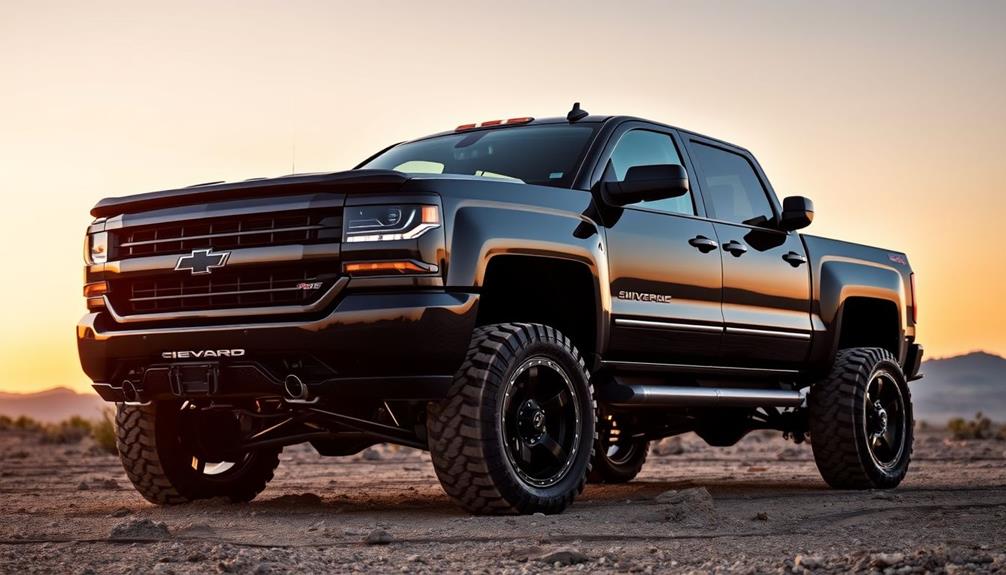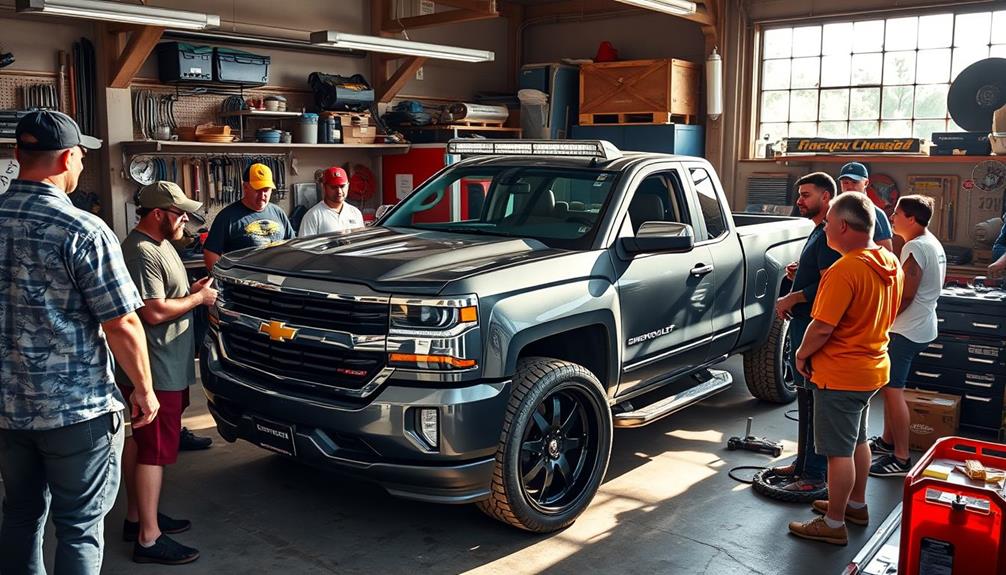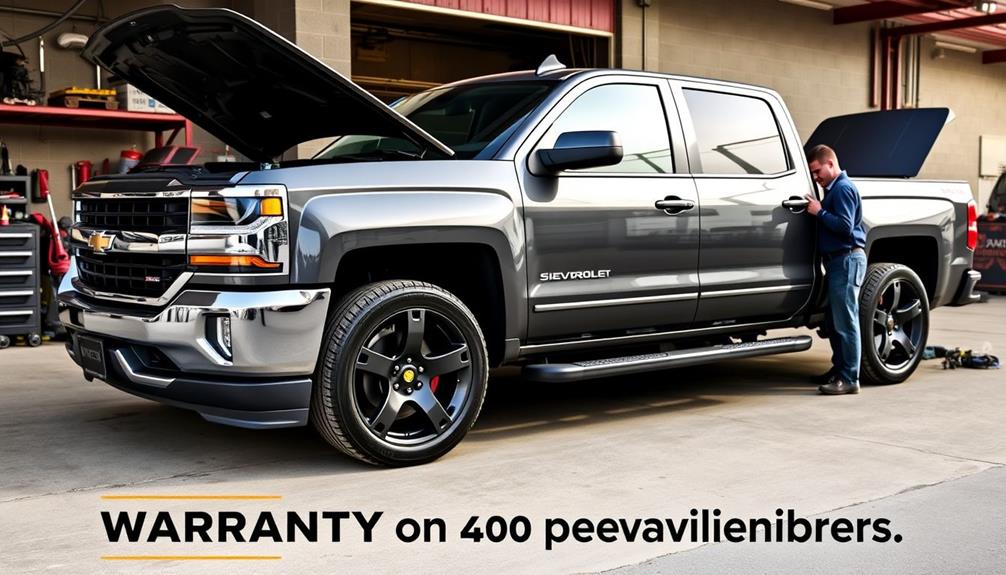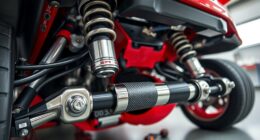Tuning your 2017 Chevrolet Silverado can elevate its performance and driving experience. You can start with popular options like the Superchips Flashpaq F5 or the DiabloSport Trinity 2 Platinum. Enhancements like upgrading your exhaust system and adding a cold air intake can boost horsepower by 10-20. Plus, tuning your engine can lead to improved fuel economy and increased throttle response. Be mindful of the costs, which can range between $1,000 and $2,000. As you explore tuning options, you'll discover ways to maximize your pickup's potential for an exhilarating ride.
Key Takeaways
- Upgrade your Silverado's exhaust system to improve airflow and potentially gain 10-20 horsepower with cat-back kits and performance mufflers.
- Consider cold air intakes for enhanced engine efficiency, resulting in additional horsepower gains and improved fuel economy.
- Utilize popular tuners like Superchips Flashpaq F5 or HPTuners for optimized performance and tailored adjustments specific to your driving needs.
- Be aware that performance tuning may void your factory warranty, so documentation of modifications is essential for future warranty claims.
- Combine tuning with modifications for a significant boost in performance, transforming your Silverado into a more responsive and powerful pickup.
Tuner Options for Silverado
When tuning your 2017 Chevrolet Silverado, you'll find a few key options to enhance its performance. The limited tuner options for Silverado are primarily due to GM's evolving computer modifications. Major manufacturers like Diablosport are still working on rolling out support for your model.
However, you can explore popular tuning devices like the Superchips Flashpaq and the Pulsar LT Programmer. These tools are designed to modify factory settings, leading to improved performance.
If you're looking for a more customized solution, consider options from HPTuners and EFI Live. These custom tuners are especially beneficial for optimizing the 5.3L engine and 8-speed transmission. Community feedback highlights the advantages of disabling Active Fuel Management (AFM) through these tuners, which can greatly boost throttle response and transform your driving experience.
Keep in mind that tuning your Silverado can cost between $1,000 and $2,000, including potential shipping costs for TCM modifications and professional installation fees.
Investing in the right tuner options for Silverado can turn your truck into a more responsive and powerful machine, enhancing both performance and enjoyment on the road.
Modifications for Enhanced Performance

Upgrading your exhaust system and adding a cold air intake can boost your Silverado's performance by improving airflow and reducing back pressure.
Choosing the right tuning device is essential, as it allows you to customize settings for maximum power and efficiency.
Together, these modifications can transform your driving experience and release the full potential of your 2017 Chevrolet Silverado.
Exhaust System Upgrades
The Silverado's exhaust system plays an essential role in maximizing engine performance, and enhancing it can lead to significant improvements. By investing in exhaust system upgrades, you can reduce back pressure, allowing for better airflow that translates into increased horsepower and torque.
High-performance exhaust systems, like cat-back kits, can enhance exhaust flow by up to 40%, offering gains of 10 to 20 additional horsepower.
A performance muffler is another effective upgrade; it not only provides a more aggressive sound but also improves exhaust flow. This can lead to better throttle response and quicker acceleration, making your driving experience more exhilarating.
Many aftermarket exhaust systems are designed to fit your Silverado seamlessly, often requiring no modifications to the truck's frame, making installation straightforward.
Additionally, using larger diameter exhaust pipes in your upgraded system can optimize exhaust flow even further. This contributes to improved fuel efficiency and enhances overall engine longevity, ensuring your Silverado performs at its best for years to come.
Cold Air Intakes
A cold air intake (CAI) can be a game changer for your 2017 Chevrolet Silverado's performance. By improving airflow to the engine, cold air intakes enable it to breathe more efficiently, resulting in noticeable gains in horsepower and torque. Many users report increases of 10-20 horsepower after installation, depending on your specific model and any additional tuning you might consider.
Additionally, it's crucial to stay informed about the potential side effects of modifications, as some changes can impact your vehicle's warranty or lead to maintenance issues. For further guidance on vehicle performance, you can explore cold medications overview to understand how various modifications might affect your engine's health.
But the benefits don't stop there. A CAI can also optimize your Silverado's fuel efficiency by enhancing the air-fuel mixture, helping you achieve better mileage during everyday driving.
If you're looking to boost performance without getting too involved, the installation process is generally straightforward and requires minimal tools—making it a favorite among Silverado owners.
When you couple cold air intakes with other performance modifications, like exhaust upgrades, you can greatly enhance overall engine responsiveness. This synergy can lead to a more exhilarating driving experience, whether you're on the highway or tackling tough terrains.
Tuning Device Selection
When it comes to boosting your 2017 Chevrolet Silverado's performance, choosing the right tuning device can make all the difference. You'll find several options that cater to your specific needs and budget.
The Superchips Flashpaq F5 is a solid choice for those with 5.3L engines; priced at $395.96, it delivers a great balance of performance and affordability. If you're after enhanced throttle response and adjustable features, consider the Pulsar LT Programmer for $458.96, designed to optimize your Silverado's performance in various driving conditions.
For more tailored modifications, custom ECU tuning through devices like HPTuners or EFI Live allows you to fine-tune your engine settings, especially helpful if you want to disable Active Fuel Management (AFM).
The Rev-X tuner, specifically for '07 to '17 5.3L Silverado 1500s, offers impressive gains of up to +27 HP and +27 lb-ft torque, enhancing both low-end torque and throttle response.
Always verify compatibility with your specific model and read user reviews to guarantee you select a tuning device that aligns with your performance enhancement goals effectively.
Tune wisely and enjoy the improved driving experience!
Cost of Tuning Your Truck

When you're considering tuning your 2017 Chevrolet Silverado, it's crucial to factor in the costs involved.
ECM tuning can set you back between $1,000 and $1,500, and if you need TCM modifications or professional installation, expenses can soar up to $2,000.
Be mindful of additional costs for tuners and possible shipping fees, as these can impact your overall budget considerably.
Estimated Tuning Expenses
Tuning your 2017 Chevrolet Silverado can be a significant investment, with estimated costs for ECM tuning typically ranging from $1,000 to $2,000.
When you factor in additional modifications and professional services, you might find that the upper end of that range is more realistic. TCM modifications could also require shipping, which adds to your overall estimated tuning expenses.
As demand for tuning rises, prices for tuners and performance modifications are expected to increase, making it wise to invest sooner rather than later.
Users often report spending considerable amounts on performance enhancements like exhaust systems and cold air intakes, which can quickly pile on to your total costs.
Consider opting for detailed tuning packages that bundle several products together. These can provide better value compared to purchasing each component separately, helping you manage your estimated tuning expenses more effectively.
In the long run, planning your budget and understanding the potential costs associated with tuning your Silverado can lead to a rewarding performance upgrade that enhances your driving experience.
Additional Modification Costs
As you consider enhancing your 2017 Chevrolet Silverado, it's essential to factor in the additional modification costs that come with tuning. The estimated cost for ECM tuning typically ranges from $1,000 to $2,000, depending on if you hire professionals and any extra components needed.
If you opt for a custom tune for the TCM, you'll likely incur shipping costs, which can add to your overall expenditure.
Performance enhancements like exhaust modifications and cold air intakes are popular, but keep in mind that these upgrades can lead to significant financial implications due to rising demand.
Prices for tuners and programmers vary; for instance, the Pulsar LT Programmer costs around $458.96, while the DiabloSport Trinity 2 Platinum is priced at $710.06. These options highlight the range of investment required for effective tuning.
Community Experiences and Insights

While exploring tuning options for your 2017 Chevrolet Silverado, you'll find valuable insights from fellow enthusiasts in online forums. Users share varied experiences with different tuning solutions, highlighting the importance of community feedback in selecting the right Power Control Module. Many members stress the need for thorough tuning support, especially for the 8-speed transmissions, which are still evolving.
Here's a glimpse into the community's shared experiences:
| Experience Type | Community Feedback |
|---|---|
| Disabling AFM | Improved performance reported |
| Recommended Tuners | HPTuners, EFI Live |
| ECM Access Challenges | Compatibility issues noted |
| Tuning Support Needs | Essential for best performance |
| Warranty Concerns | Risks highlighted, proceed with caution |
As you dive deeper into these discussions, you'll notice how disabling Active Fuel Management (AFM) has become a popular topic, with many owners reporting better performance. However, be mindful of the warranty implications when modifying your truck. Engaging in these community conversations will not only help you make informed decisions but also connect you with other Silverado enthusiasts who share your passion for performance tuning.
Benefits of Performance Tuning

Releasing your 2017 Chevrolet Silverado's potential through performance tuning can lead to significant benefits that enhance your driving experience. By optimizing engine settings, you can expect improvements in various aspects of your truck's performance.
Here are some key benefits of performance tuning:
- Improved Fuel Economy: Tuning can enhance miles per gallon, especially when paired with modifications like cold air intakes and exhaust systems.
- Increased Power: Many drivers report gains of up to +27 HP and +49 lb-ft torque, giving your Silverado the muscle it needs for demanding tasks.
- Enhanced Throttle Response: Tuning boosts throttle response and acceleration, making your truck feel more agile—perfect for towing or hauling heavy loads.
Additionally, by disabling Active Fuel Management (AFM), you'll experience a more consistent power delivery and a more aggressive driving experience.
Custom ECU tuning allows you to tailor adjustments based on your specific driving conditions and preferences, enhancing overall drivability.
Whether you’re looking for better efficiency or increased performance, performance tuning transforms your Silverado into a more capable machine. And when it comes to classic truck tuning, there are a variety of options to choose from to suit your specific needs and preferences. From upgrading the exhaust system to installing a cold air intake, classic truck tuning allows you to customize your Silverado to better fit your driving style. With the right tuning, you can experience a noticeable improvement in horsepower, torque, and fuel economy, making every drive in your Silverado even more enjoyable.
Warranty and Tuning Considerations

When considering performance tuning for your 2017 Chevrolet Silverado, it's vital to understand how it might affect your warranty. Tuning can void the factory warranty for modified components, so knowing which aspects of your vehicle's warranty remain intact is important.
Typically, non-ECM related issues still fall under warranty, allowing for some coverage after you make performance modifications.
To protect your warranty rights, document all modifications and tuning changes meticulously. This documentation can be invaluable when discussing claims with dealerships. Additionally, consider tuners who offer written guarantees of compatibility with your specific model; this can help maintain your warranty coverage.
Before diving into tuning, take the time to evaluate the terms and conditions of your vehicle's warranty. Understanding these details can save you from unexpected costs and potential loss of coverage.
Frequently Asked Questions
How Can I Increase the Horsepower of My Silverado?
You can increase your Silverado's horsepower by installing a plug-and-play tuner, upgrading to a high-flow cold air intake, enhancing exhaust systems, and utilizing custom ECU tuning for tailored performance that fits your driving style.
Can You Tune a Chevy Silverado?
Yes, you can tune a Chevy Silverado. Using performance programmers or handheld tuners, you'll enhance horsepower and torque, improve throttle response, and customize your driving experience. Just verify compatibility with your specific model before purchasing.
What Is the Silverado Performance Upgrade Package?
The Silverado Performance Upgrade Package boosts your truck's power and efficiency. It includes a performance tuner, upgraded exhaust, and high-flow air intake, enhancing throttle response, towing capacity, and overall drivability while remaining emissions compliant.
Why Doesn T Chevy Make a Performance Truck?
Chevy focuses on crafting versatile trucks that cater to everyone's needs, prioritizing reliability and comfort. While a performance truck would be exciting, it may not align with their broader market appeal and customer expectations.
Conclusion
So, are you ready to transform your 2017 Chevrolet Silverado into a performance powerhouse? With the right tuner options and modifications, you can release its true potential while reaping the benefits of enhanced power and efficiency. But wait—what about warranties? Don't let that hold you back! Immerse yourself in the world of tuning, and you might just discover the thrilling ride you've always dreamed of. Your Silverado's performance journey is just a decision away. What'll you choose?










